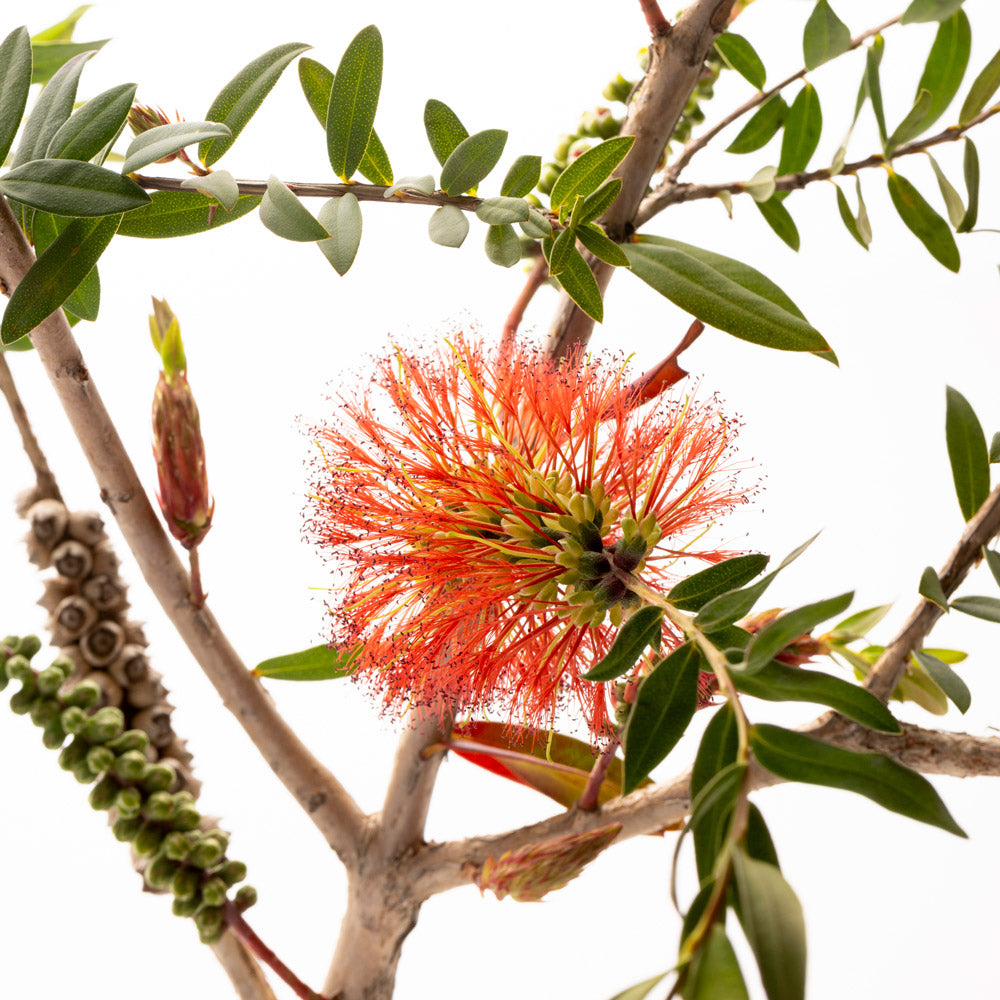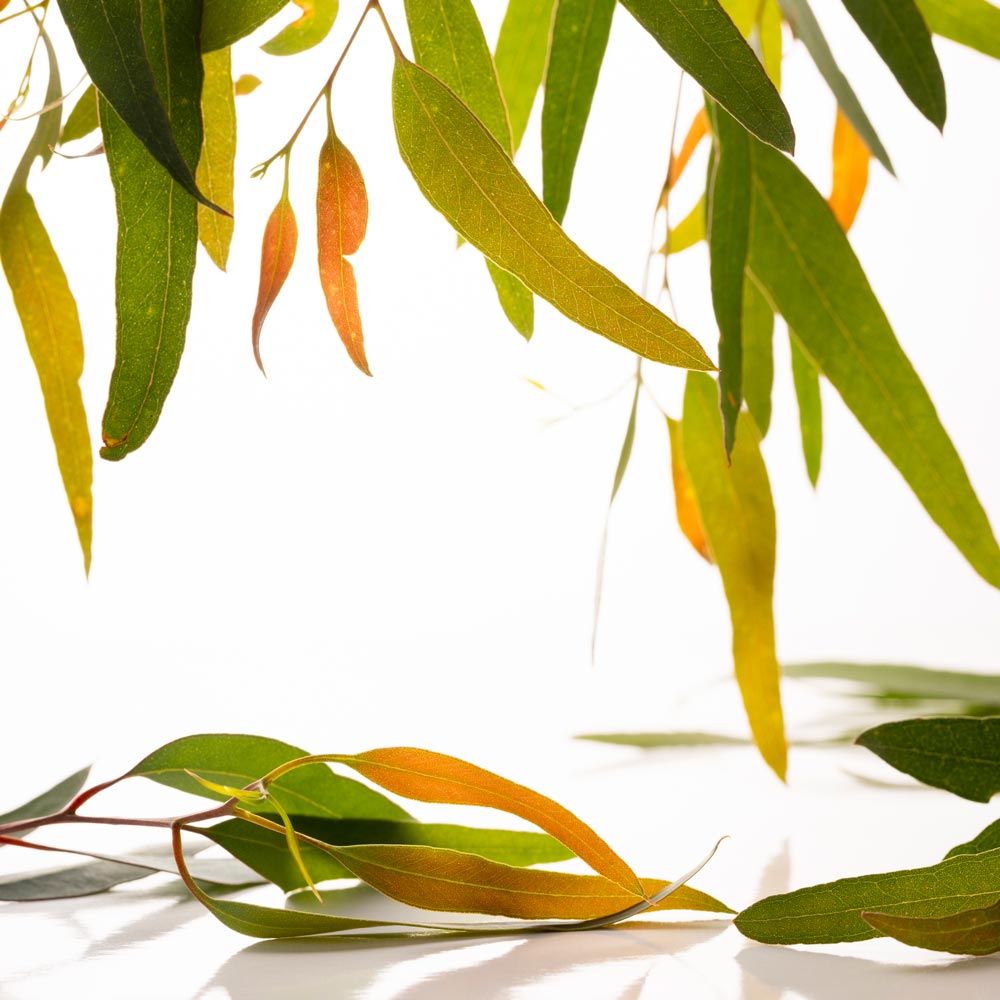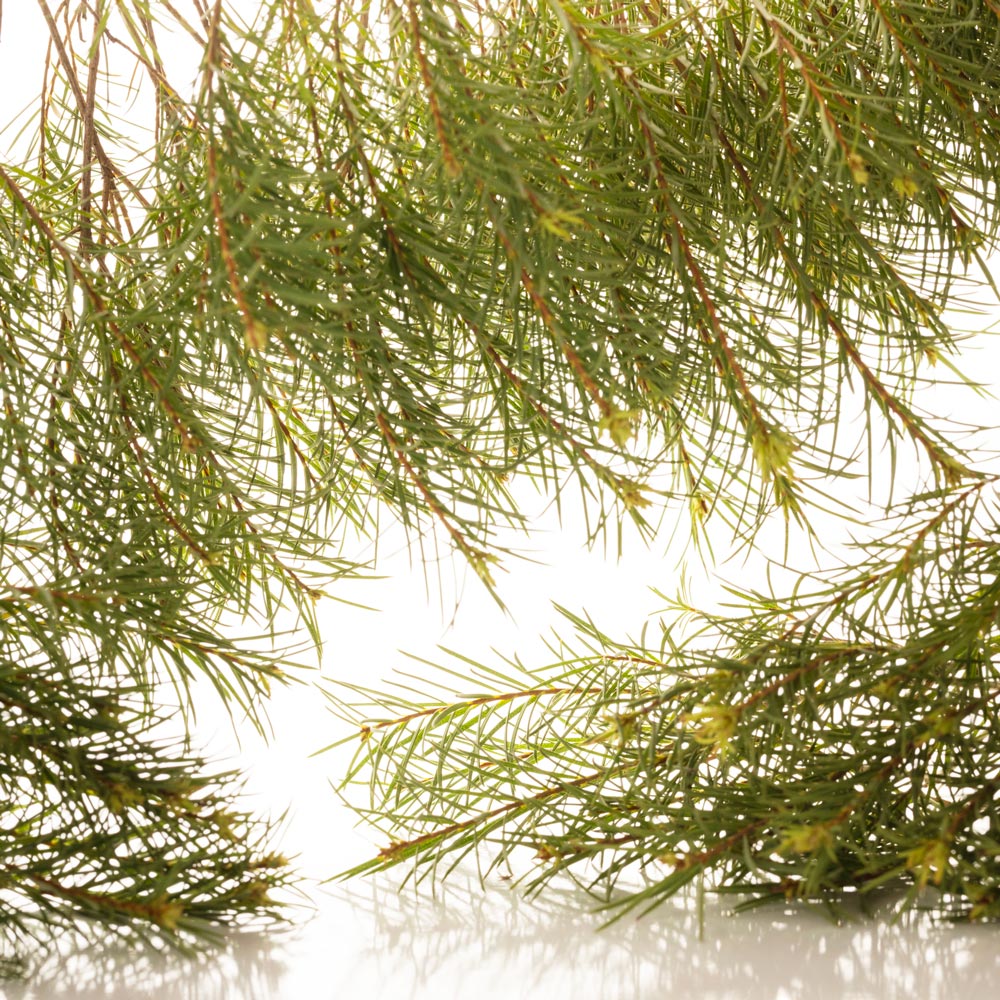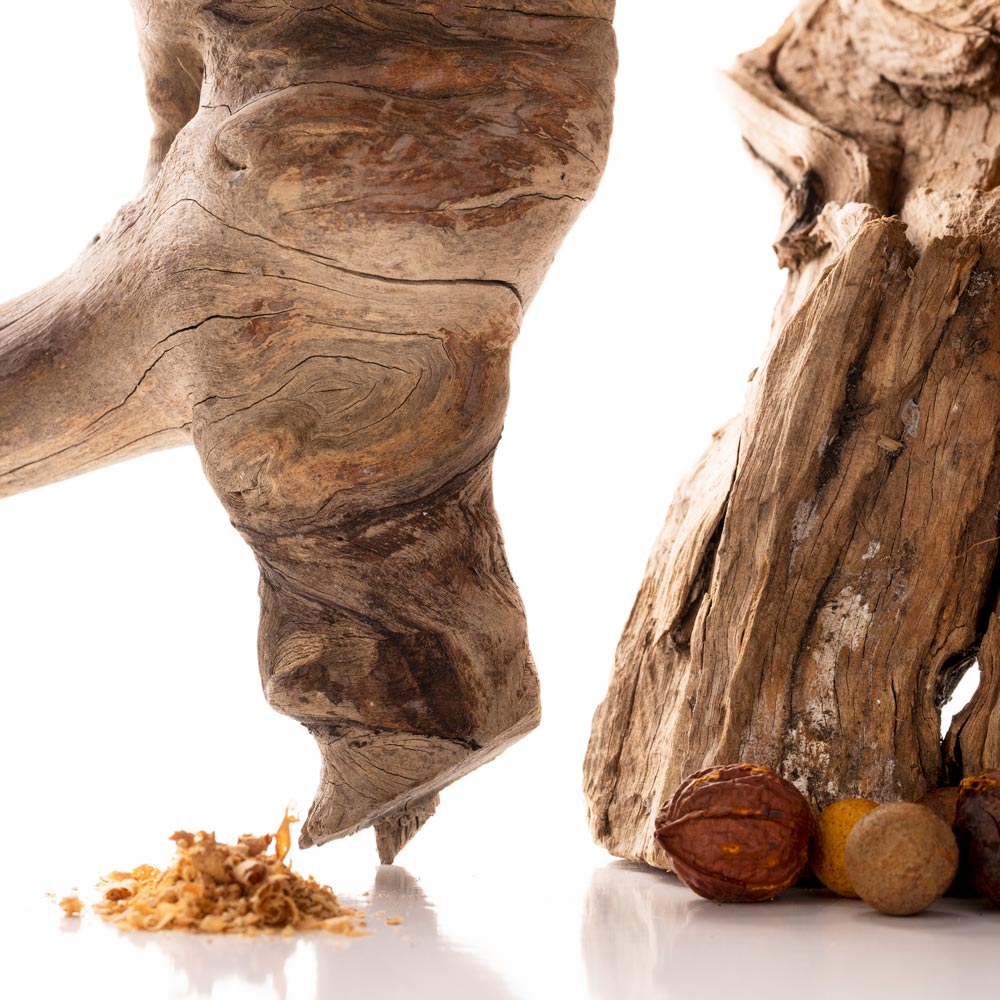Botanical Glossary
At Blue Moon Distillers, we grow, pick, harvest and distill our botanical aromatics - from plant to bottle.
Tangerine Tea Tree
COMMON NAME: Tangerine Tea Tree
BOTANICAL NAME: Melaleuca hyperficifolia

Endemic Region
Temperate coastal & sub-coastal regions of NSW, from Gosford to Tathra.
COUNTRY OF ORIGIN: Australia
Description of Oil
A sweet yet earthy oil used in our Four Winds and Bermagui Body Oil Blends. Tangerine Tea Tree offers a refreshing blend of bright, zesty citrus alongside warm herbaceous greenery.
Principal Benefits
Anti-microbial, reduces inflammation and works as a decongestant.
Traditional Uses
Used externally to treat various skin infections and relieve headaches.
Oil Composition by GC-MS
(Gas Chromatography – Mass Spectometry)
Below is a list of the individual aromatic compounds that make up this particular oil.
Essential oils, particularly those from Australian native plants, often share common aromatic compounds. However, the unique ratio and presence of
minor aromatic compounds can vary significantly. These minor compounds typically work in harmony with the primary notes, enhancing the overall
fragrance profile. The expertise of a skilled distiller ensures a
balanced spectrum of aromatic compounds, reflecting the quality of both the raw materials and the distillation process. This careful crafting
results in an essential oil that stands out as both significant and distinctive in its own right.
GC-MS Data from analysis of Melaleuca hyperficifolia
1,8-Cineole = 86.6%
Limonene = 7.2%
Alpha-Pinene = 2.8%
Alpha-Terpineol = 1.2%
Beta-Pinene = 1.0%
Myrcene = 0.4%
Unknown trace = 0.3%
Para-cymene = 0.2%
2-Methyl-Butyl Acetate = 0.2%
Terpinen-4-ol = 0.2%
Fine Leaf Peppermint Gum
COMMON NAME: Peppermint Gum
BOTANICAL NAME: Eucalyptus radiata var: Australiana

Endemic Region
East Coast NSW, North East Victoria, High Country and Eastern slopes down to Tasmania.
COUNTRY OF ORIGIN: Australia
Description of Oil
Peppermint Gum is a crisp, invigorating botanic featured in our Four Winds and Bermagui Body Oil Blends. This unique oil delivers a cool, minty freshness alongside subtle, grounding notes of eucalyptus.
Principal Benefits
Has been traditionally used to relieve muscular aches and pains. It is beneficial in relieving symptoms of colds and flu when used in steam inhalation.
Traditional Uses
Antibacterial properties & has high antiseptic qualities. It can be used in most of the traditional essential oil methods, greatly used in diffusers to lighten up the room. Has been used for inhalation for coughs and colds.
Oil Composition by GC-MS
(Gas Chromatography – Mass Spectometry)
Below is a list of the individual aromatic compounds that make up this particular oil.
Essential oils, particularly those from Australian native plants, often share common aromatic compounds. However, the unique ratio and presence of
minor aromatic compounds can vary significantly. These minor compounds typically work in harmony with the primary notes, enhancing the overall
fragrance profile. The expertise of a skilled distiller ensures a
balanced spectrum of aromatic compounds, reflecting the quality of both the raw materials and the distillation process. This careful crafting
results in an essential oil that stands out as both significant and distinctive in its own right.
GC-MS Data from analysis of Eucalyptus radiata var: Australiana
1,8-Cineole = 80.44%
Limonene = 6.45%
Alpha-Pinene = 5.02%
Alpha-Terpineol = 1.72%
Beta-Pinene = 0.54%
Myrcene = 0.77%
Terpinen-4-ol = 0.2%
alpha-terpineol = 1.72%
Tea Tree
COMMON NAME: Tea Tree Oil
BOTANICAL NAME: Melaleuca alternifolia

Endemic Region
Melaleuca alternifolia is endemic to Australia and occurs from Grafton district in New South Wales and inland to the base of New England Ranges and as far north as the coastal districts north to Maryborough in Queensland. It grows along streams and in swampy places.
COUNTRY OF ORIGIN: Australia
Description of Oil
Tea Tree Oil is a potent antimicrobial essence offered as a 100% pure distilled essential oil in the Blue Moon range. Renowned for its crisp medicinal aroma, it delivers a sharp burst of herbal clarity. This oil embodies a robust, antiseptic quality, ideal for invigorating the senses.
Principal Benefits
Tea tree oil is commonly used to treat insect bites, acne, lice and nail fungus.
Traditional Uses
Due to its huge scope of uses it is known as the first aid kit in a bottle. From being used by First Nation people for ever to surfers commonly keep a bottle in their kit to treat coral or oyster cuts from getting infected. (Going Troppo) A very interesting application was the use of it in machine cutting oil during World War II. If a machinist accidentally cut themselves it reduced the risk of infection and time off work during an important time in the history of the world.
Oil Composition by GC-MS
(Gas Chromatography – Mass Spectometry)
Below is a list of the individual aromatic compounds that make up this particular oil.
Essential oils, particularly those from Australian native plants, often share common aromatic compounds. However, the unique ratio and presence of
minor aromatic compounds can vary significantly. These minor compounds typically work in harmony with the primary notes, enhancing the overall
fragrance profile. The expertise of a skilled distiller ensures a
balanced spectrum of aromatic compounds, reflecting the quality of both the raw materials and the distillation process. This careful crafting
results in an essential oil that stands out as both significant and distinctive in its own right.
GC-MS Data from analysis of Melaleuca hyperficifolia
1,8-Cineole = 86.6%
Limonene = 7.2%
Alpha-Pinene = 2.8%
Alpha-Terpineol = 1.2%
Beta-Pinene = 1.0%
Myrcene = 0.4%
Unknown trace = 0.3%
Para-cymene = 0.2%
2-Methyl-Butyl Acetate = 0.2%
Terpinen-4-ol = 0.2%
Lavaleuca
COMMON NAME: Swamp Paperbark, Lavaleuca
BOTANICAL NAME: Melaleuca ericifolia

Native Region
Damp places, especially around coastal lagoons and swamps, extending from Northern New South Wales to Victoria and Tasmania.
COUNTRY OF ORIGIN: Australia
Description of Oil
Lavaleuca essential oil offers a wonderfully sweet, inviting fragrance. Perfect for use in an oil burner, it imparts soothing, sedative effects, while its inclusion in a massage oil base can help alleviate muscular aches and pains. Ongoing clinical research is exploring its full range of benefits.
Principal Benefits
Anti-microbial, relaxant (anti stress), anti-inflammatory, expectorant, promotes sleep and improves respiration.
Traditional Uses
The leaves where used for poultice but the bark was used more often for wrapping fish in for cooking on hot coals and also for roofing of houses.
Oil Composition by GC-MS
(Gas Chromatography – Mass Spectometry)
Below is a list of the individual aromatic compounds that make up this particular oil.
Essential oils, particularly those from Australian native plants, often share common aromatic compounds. However, the unique ratio and presence of
minor aromatic compounds can vary significantly. These minor compounds typically work in harmony with the primary notes, enhancing the overall
fragrance profile. The expertise of a skilled distiller ensures a
balanced spectrum of aromatic compounds, reflecting the quality of both the raw materials and the distillation process. This careful crafting
results in an essential oil that stands out as both significant and distinctive in its own right.
GC-MS Data from analysis of Melaleuca ericifolia
Linalool: 56:86%
1,8 Cineole: 26:9%
Alpha-pinene: 3:87%
Para-cymene: 3.07%
Limonene: 2.6%
Kunzea
COMMON NAME: Tick Bush, White Cloud & Kunzea
BOTANICAL NAME: Kunzea ericoides

Endemic Region
South Coast NSW to Tasmania.
COUNTRY OF ORIGIN: Australia
Description of Oil
Kunzea ericoides, commonly known as Tick Bush or White Cloud, is an Australian native plant prized for its essential oil, which is extracted from its leaves and twigs. This oil is celebrated for its anti-inflammatory, analgesic, and
antimicrobial properties, making it valuable for relieving muscle and joint pain and promoting wound healing. It features a fresh, woody scent
with subtle medicinal notes, and is versatile in use—ideal for aromatherapy, massage, and formulations in lotions, creams, and soaps.
With its distinctive Australian bush aroma, Kunzea ericoides has gained global recognition for its unique qualities and therapeutic benefits. It is now on the path to achieving International Standards, reflecting its growing popularity and significance worldwide.
Principal Benefits
The constituents in Kunzea are known to have effective anti-inflammatory, anti-microbial, antiseptic and properties.
Traditional Uses
Kunzea has been used for millennium by First nation groups for medicinal purposes and also the thin branches where often used for weaving fish traps as it is stable under water. Also non First Nation peoples have used this plant in the same ways for fish traps and lobster pots even up to today it is used this way in Tasmania.
Oil Composition by GC-MS
(Gas Chromatography – Mass Spectometry)
Below is a list of the individual aromatic compounds that make up this particular oil.
Essential oils, particularly those from Australian native plants, often share common aromatic compounds. However, the unique ratio and presence of
minor aromatic compounds can vary significantly. These minor compounds typically work in harmony with the primary notes, enhancing the overall
fragrance profile. The expertise of a skilled distiller ensures a
balanced spectrum of aromatic compounds, reflecting the quality of both the raw materials and the distillation process. This careful crafting
results in an essential oil that stands out as both significant and distinctive in its own right.
GC-MS Data from analysis of Kunzea ericoides
The main compounds are:
alpha-pinene
viridiflorol
1,8- cineole
and sesquiterpenes.
Australian Sandalwood Oil
COMMON NAME: Australian Sandalwood Oil
BOTANICAL NAME: Santalum spicatum

FOUND IN:
Endemic Region
Western Australia, Northern Territory & South Australia.
COUNTRY OF ORIGIN: Australia
First Nations' Uses
First Nation peoples were the first sandalwood custodians and the traditional owners of the lands and deserts from where sandalwood originally grew and thrived. Sandalwood grew across a huge area of Western Australia. It grew across many Nations and was traded between clan groups for other commodities such as medicines, tools & food. Due to being so wide spread across many Nations each clan had different names for the Sandalwood. Some of those names are birdilyba, kirti, munyunpa, parnjal, pikarra, tarrtjanpa, tatjan, tujan(pa), thumbuny, walarda, walku, warlka, wirawayin (GALCAC, 2022), uilarac, waang, willarak, wolgol, wollgat (Abbott, 1983), poilyenum (Bindon and Chadwick, 1992)1 , native sandalwood or Western Australian sandalwood.
Some of those First Nation Nations are listed below:
- Noongar Ballardong
- Gwoonwardu
- The Pitjantjatjara, the Arrernte, the Luritja and the Warlpiri
- Kurl-Kurti
- Esperance Nyungars
- Yinggarda and Baiyungu people
- Yamatji people
- Pintupi
- Tjuntjuntjara
- Martu people
- Ngadju people
- Ngurai-illum Wurrung people
- Mirning and Yinyila people
- Yindjibarndi
- Yalgoo
Description of Oil
An exquisitely balanced oil with earthy, grounding, and calming
qualities. It offers a rich base note that imparts a settling aroma,
making it a perfect foundation in any blend.
Principal Benefits
Our prized Sandalwood Oil benefits are calming, helping you stay grounded and relaxed. It is used extensively for meditation and clearing houses or rooms, improving clarity of mind.
Traditional Uses
It has been ground to a paste and ingested for digestion complaints to mosquito repellent. Also the wood has been burnt in houses or camps for settling of mind, body & spirit.
Oil Composition by GC-MS
(Gas Chromatography – Mass Spectometry)
Below is a list of the individual aromatic compounds that make up this particular oil.
Essential oils, particularly those from Australian native plants, often share common aromatic compounds. However, the unique ratio and presence of
minor aromatic compounds can vary significantly. These minor compounds typically work in harmony with the primary notes, enhancing the overall
fragrance profile. The expertise of a skilled distiller ensures a balanced spectrum of aromatic compounds, reflecting the quality of both the raw materials and the distillation process. This careful crafting results in an essential oil that stands out as both significant and distinctive in its own right.
GC-MS Data from analysis of Santalum spicatum
alpha-santalol = 17.4%
epi-a -bisabolol = 5.6%
a-trans-bergamotol = 2.7%
beta-santalol = 1.4%
alpha santalol = 5.8%
farnesol = 10.8%
nuciferol =8.1%
lanceol = 3.1%
MCT (Base Oil)
COMMON NAME: MCT
BOTANICAL NAME: Cocos nucifera

Endemic Region
Sth Pacific, Melanesia, Tropical countries around the world.
COUNTRY OF ORIGIN: Australia
Description of Oil
MCT, or medium-chain triglycerides, are a refined form of coconut oil with the heavier fats and waxes removed. At Blue Moon Distillers, we ensure our MCT is extracted through a gentle, refrigerated centrifuge process. While there are chemical extraction methods, we exclusively source our MCT from reputable suppliers who utilise this milder technique to maintain purity and quality.
Principal Benefits
MCT oil is absorbed directly and quickly when applied to the skin. It can provide an instant source of energy to the skin cells whilst acting as a carrier for the essential oils we have formulated into the product. It boosts & enhances the skin's ability to regenerate & repair itself.
Traditional Uses
Coconut oil has been used by islanders around the world for millennium. Uses include, skin moisturiser, fuel for lamps to light houses, wood oiling and the macas (over fibre) from the expression of the oil is used for pig or cattle food in villages.
Oil Composition by GC-MS
(Gas Chromatography – Mass Spectometry)
Below is a list of the individual aromatic compounds that make up this particular oil.
Essential oils, particularly those from Australian native plants, often share common aromatic compounds. However, the unique ratio and presence of
minor aromatic compounds can vary significantly. These minor compounds typically work in harmony with the primary notes, enhancing the overall
fragrance profile. The expertise of a skilled distiller ensures a balanced spectrum of aromatic compounds, reflecting the quality of both the raw materials and the distillation process. This careful crafting results in an essential oil that stands out as both significant and distinctive in its own right.
GC-MS Data from analysis of MCT
Caprylic acid
Capric acid
Lauric acid
Miristic acid
Palmitic acid
Stearic acid
Oleic acid
Linolleic acid
lanceol = 3.1%





